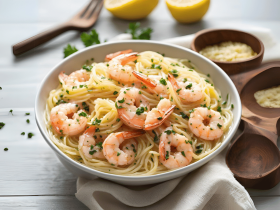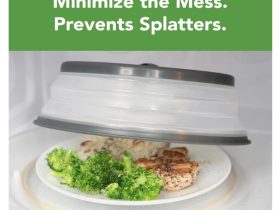In today’s fast-paced world, the convenience of microwave cooking is unmatched. Whether you’re reheating leftovers, steaming vegetables, or melting chocolate, using microwave-safe dishes is crucial for both safety and cooking efficiency. These Microwave-Safe Bowls and Containers are typically made from materials like glass, ceramic, or certain plastics, each marked with a microwave-safe symbol.
This symbol is your assurance that the product has been tested and approved for microwave use. Choosing the right microwave-safe containers not only preserves the quality and taste of your food but also contributes to a healthier, more sustainable lifestyle by reducing the risk of chemical leaching. Embracing these safe cooking practices ensures that your meals are not only quick and convenient but also safe and nutritious.
The Importance Of Microwave-Safe Bowls And Containers
Everyone loves a quick meal. Microwaves make this easy. But, not all bowls are safe in them. Using the right containers stops your food from getting chemicals. This is why microwave-safe containers are a must.
Material Safety
Some materials are safe for microwaves, and some are not. Here is a simple guide:
- Glass: Usually safe, but check for a microwave-safe label.
- Plastic: Be careful! Look for a microwave-safe symbol. Some plastics melt.
- Ceramic: Mostly safe, but avoid those with metallic paint.
- Paper: Paper plates and towels are okay, but not all paper products.
Always check your bowls and containers before using them. This keeps you and your food safe.
Preventing Chemical Leaching
Chemicals can move from containers to your food. This is not good. Here’s how to stop it:
- Use marked microwave-safe containers: They are tested for safety.
- Avoid old, scratched containers: Harmful chemicals can hide in scratches.
- Do not microwave plastic storage bags or take-out containers: They are not made for heating.
- Limit microwave use with plastic: Use glass or ceramic when you can.
Choosing the right container keeps your food safe from chemicals. Always check labels and replace old containers.

Understanding Microwave-safe Bowls
Many bowls and containers are used in microwaves every day. It is important to know which ones are safe. Some Bowls on these items tell us if they can go in a microwave. This helps us avoid dangerous mistakes. Let’s learn about these symbols and their meanings.
Decoding The Bowls
On bowls and containers, you might see some pictures or words. These are Bowls. They tell us if we can use the item in a microwave. Look for a symbol that looks like a microwave or has some waves. Sometimes, the word “microwave” with a safe sign is there. This means the item is safe to use. Here are some Bowls and what they mean:
- Squiggly lines: Heat is okay.
- Dish with waves above: Microwave safe.
- Numbers: Show how hot the item can get.
Some containers have a table on the bottom. This table has more details. It shows the highest temperature the item can handle. Look for this table before using your container.
Common Misinterpretations
Symbols can sometimes confuse us. A dish in water might not mean it’s safe for microwaves. It could mean the dish is only safe for dishwashers. Here’s what people often get wrong:
- Dish in water: This means dishwasher safe, not microwave safe.
- Snowflake: This means freezer safe. It is not for microwaves.
- Check the manual: If unsure, read the guide that came with your dish.
Remember, just because a container doesn’t melt, it doesn’t mean it’s safe. Chemicals can get into your food. Always check for the right symbols.
Types Of Microwave-safe Materials
Understanding which bowls and containers are safe for microwave use is key to kitchen safety. Microwaves heat food quickly and easily. But, using the wrong materials can be dangerous. There are specific materials designed for microwave use. Let’s explore the best types of microwave-safe materials.
Glass And Ceramic
Bowls and containers made of glass or ceramic are great for microwaves. They can handle heat well and won’t melt or release harmful chemicals. Here are reasons to use them:
- Glass bowls are often clear, making it easy to see your food.
- Ceramic containers can also be microwave-safe if they don’t have metallic paint.
- Both materials don’t absorb food odors or colors.
- They are usually dishwasher safe, making clean-up simple.
Check for a microwave-safe label before using glass or ceramic in your microwave. Some items like fine china or glass with gold trim are not safe.
Plastic And Silicone
Plastics are common in kitchens, but only some types are safe for microwaves. Silicone is a newer option that’s gaining popularity. Here’s what you should know:
- Plastic containers should have a microwave-safe symbol.
- Containers without this symbol can melt or release chemicals.
- Silicone is heat-resistant and safe for microwaves.
- It is soft, flexible, and comes in fun colors.
Always check the bottom of plastic or silicone items for the microwave-safe label. Avoid using single-use plastic containers. They are not designed for heating.

Best Practices For Microwave Use
Understanding how to use microwave-safe bowls and containers is key to kitchen safety. Microwaves heat food quickly and easily. But it’s important to use the right dishes. This ensures your food heats evenly and prevents accidents. Let’s look at some top tips for microwaving your food safely.
Avoiding Hot Spots
Hot spots are areas in microwaved food that are much hotter than others. They can cause burns or uneven cooking. To avoid them, follow these tips:
- Stir your food halfway through the cooking time.
- Use microwave-safe cookware that allows heat to spread evenly.
- Rotate your dish a few times while cooking, if your microwave doesn’t have a turntable.
Remember, some foods heat up faster than others. Foods high in sugar or fat will get hot quickly. Always use caution when checking the temperature of your food.
Covering And Venting
Properly covering and venting your food plays a big role in microwave safety:
- Cover food with a microwave-safe lid or plastic wrap. This keeps in steam and heats food evenly.
- Make sure to leave a corner open or poke holes in the plastic wrap. This allows steam to escape and prevents burns.
- Avoid plastic containers that are not labeled microwave-safe.
Doing this not only cooks food better but also keeps your microwave clean from food splatter. Always check your food’s temperature before eating to make sure it’s fully cooked.
Identifying Unsafe Containers
Understanding which “Microwave-Safe Bowls And Containers” Ultimate Guide are safe for microwaves is important. It keeps our food free from harmful chemicals. It also prevents accidents in the kitchen. Today, we look at how to spot containers that might be unsafe when heated in a microwave.
Metal And Foil
Putting metal or foil in a microwave is a bad idea. It can cause sparks and even start a fire. Microwaves bounce off metal, so they can’t warm up your food. Always use containers without any metal parts. Here are some tips to keep you safe:
- Never use metal pans or aluminum foil in a microwave.
- Check if containers have a metal rim. If they do, do not use them.
- Use containers marked as ‘microwave-safe’ instead.
Some containers have metal hidden inside. It is hard to see it, but it is still dangerous. Always test if you’re not sure. You can do this by microwaving the container for a very short time with water inside. If it gets hot very fast, it might have metal. Do not use it.
Unlabeled Or Unknown Materials
Containers without labels can be risky. We can’t tell if they are safe or not. Only use containers that say ‘microwave-safe’. Be careful with take-out boxes and plastic tubs. They might not be made for microwaves. Here’s what you can do:
- Look for the microwave-safe symbol. It looks like a microwave or some waves on the bottom of the container.
- If there is no label, choose another container you know is safe.
- Remember, not all ‘dishwasher-safe’ labels mean ‘microwave-safe’.
Plastic can release bad chemicals if it gets too hot. Glass or ceramic containers are often better choices. Make sure they don’t have any metallic paint or trim. Those are not safe for microwaves. When in doubt, pick something else to heat your food in.
Tips For Safe Microwaving
Understanding which bowls and containers are safe for microwaves is crucial. Using the wrong ones can be dangerous. This guide will help you choose the right containers and keep them in good shape for microwaving.
Testing Containers
Not all containers are safe for microwave use. It’s important to know how to test them. Here is an easy way to check if your container is microwave-safe:
- Fill a glass with water.
- Place the glass inside the microwave beside the container you want to test.
- Heat them for one minute on high power.
- Touch the container. If it’s hot, it’s not safe for microwaving.
- The water should be hot while the container stays cool.
Always look for a label that says ‘microwave-safe.’ This label means the manufacturer has tested it for safety.
Regular Inspection
Containers wear out over time. Regular checks are important to ensure they stay safe for use. Here’s what to look for:
- Check for cracks or damage.
- Look for fading labels or symbols.
- Make sure the lid fits snugly and securely.
- Discard any container that seems worn out or damaged.
Remember to replace old containers with new ones when necessary. This practice helps prevent accidents and keeps your food safe.
Impact Of Non-microwave-safe Containers
Understanding microwave-safe bowls and containers is crucial for our health and food. Not all containers can handle microwave heat. Some may melt or release harmful chemicals. This can affect both our health and the food we eat. It’s important to use the right type of container when heating food in a microwave.
Health Risks
Using the wrong bowls in a microwave poses health risks. Here are some dangers:
- Chemical leaching: Hazardous chemicals might mix with food.
- Burns: Containers can get too hot and cause burns.
- Fire hazards: Some materials can catch fire in a microwave.
Studies show certain plastics release BPA when heated. This chemical may lead to health issues. It can affect the brain and hormone levels. Using microwave-safe bowls reduces these risks.
Food Quality
The quality of food can suffer in non-safe containers. Here’s what can happen:
- Uneven heating: Some spots get too hot, others stay cold.
- Nutrient loss: The wrong container can destroy good stuff in food.
- Taste changes: Chemicals can make food taste weird.
A safe container helps food cook evenly. It keeps your meal tasty and healthy. Using the right bowl or container is key for good food. Always check for a microwave-safe label before using it.

Conclusion And Recommendations
Many people use microwaves daily. It’s important to know which bowls and containers are safe. This ensures food heats well without any health risks. Let’s explore how to pick and use microwave-safe options effectively.
Safe Practices
Using microwave-safe containers correctly is key to safety and efficiency. Here are some tips:
- Check labels on containers for the microwave-safe symbol.
- Avoid metal and aluminum foil in microwaves. They can cause sparks.
- Use a lid or vent to allow steam to escape, preventing splatters.
- Stir food midway through heating. This helps it cook evenly.
- Let food sit for a few minutes after microwaving. It continues to cook.
Following these steps helps keep you and your family safe.
Choosing The Right Containers
Finding the right microwave-safe containers involves knowing what materials are safe. Here’s a guide:
| Material | Is it Safe? |
| Glass | Yes, especially if labeled microwave-safe. |
| Ceramic | Yes, but check for a microwave-safe label. |
| Plastic | Be cautious. Only use if it has a microwave-safe symbol. |
| Paper | Often safe, but avoid paper with shiny coatings. |
Choosing the right container is simple with this knowledge. Always look for the microwave-safe symbol. Remember, safety and health come first.
Frequently Asked Questions
Microwave-safe bowls are typically made of glass, ceramic, or certain plastics. Always check for a microwave-safe label before use. Avoid metal and single-use plastic containers in microwaves.
Microwave-safe containers include glass, ceramic, and certain BPA-free plastics marked with a microwave-safe label. Avoid metal and unmarked plastic containers to prevent damage and chemical leaching. Always check for a microwave-safe symbol before use.
Check the container for a microwave-safe label or symbol. Conduct a microwave test by heating the container with water inside. If the container stays cool but the water warms up, it’s microwave safe. If the container heats up, do not use it in the microwave.
The symbol for microwave safe containers is a microwave with wavy lines or simply the word “microwave” on it. This indicates the container can safely be used in a microwave. Always check for this symbol to ensure safe reheating or cooking in microwave ovens.
























Leave a Reply